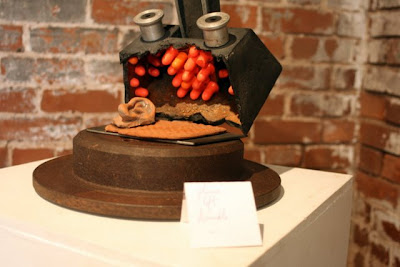 Group Seven collaborative show at Whitespace Gallery. The burns on this mammoth-sized abstract indicate some seriously intense heat. (Photos by Ben Grad. You can view a larger selection at Ben's Picasa site here.)
Group Seven collaborative show at Whitespace Gallery. The burns on this mammoth-sized abstract indicate some seriously intense heat. (Photos by Ben Grad. You can view a larger selection at Ben's Picasa site here.)Group Seven is the local branch of The Imagillaboration Project, a nationwide network of sculptors collaborating through the exquisite corpse method first championed by André Breton and other French Surrealists.
The premise is simple: each sculptor creates a "seed," which, as it rotates between artists, evolves in a process of growth, dissection, and reassembly. Although some variations of the game are "blind," each participant here must consciously react to the additions made by the previous artist. Here's an example by Group Six, a peer group based in Ohio and Michigan.
Rather than a traditional, single-perspective review, I thought it would be appropriate to respond as a collective. In the spirit of the exquisite corpse, I'm joined by fellow bloggers:
The discussion below follows a similarly themed format; each writer picks one sculpture and begins a description, an inspirational "seed," to be continued by the other two.Susannah Darrow (Il Faut Cultiver Notre Jardin)
and
Ben Grad (Proclaim It Lost)
 Julia's Seed, collaborative sculpture.
Julia's Seed, collaborative sculpture.Ben: An iron filing bezoar perches atop an etched limestone pillar, itself balanced between the four legs of something like an inverted stool. There's an urge to describe the individual components of these structures—to ascribe an artist to each favorite material, structural element, or technique.
Susannah: In this desire to connect each material with a personalized identity, Group Seven’s exquisite corpse has proven itself quite successful. A personification of each artist can be seen in every scrap and oddity. Though this individualism within the sculpture has far from compromised the overall unity of the piece. Every rusted leg compliments the smoother, polished sphere that crowns the sculpture. The dreadlock-like tendrils mirror back at the rusted supports. No material is unconsidered and no placement arbitrary.
Jeremy: Although it might be interesting to play detective and link each component to a specific “author,” it would be a little exhausting. I’d rather not distract myself from appreciating the piece as a complete experience. With that said, I do see a kind of vague individualism. Although that sliver of wood—jutting like a slice of carrot alongside the central limestone column—is a very minor addition, it adds a bit of unexpected contrast. Compared to the outright eclecticism of Patrick’s Seed, Julia’s Seed achieves a very tasteful moderation between anonymous experimentation and editorial control. While I love Patrick’s Seed, with its little train cars and graffiti, there’s a greater cohesion here between each part.
 Matt's Seed, a kinetic, collaborative sculpture. If you can find images no. 17 and 18, you can create your own "animation" by clicking back and forth.
Matt's Seed, a kinetic, collaborative sculpture. If you can find images no. 17 and 18, you can create your own "animation" by clicking back and forth. Susannah: There is a temptation to describe this work in the same sentiment as one would discuss items with a sense of childhood nostalgia. Each element of the sculpture has been worn-in considerably from playmate to playmate and assigned roles previously unimagined.
Jeremy: Nostalgia, perhaps… for sandbox games? I’m reminded of twig bridges over moats guarding towers of cold, red clay. Playing in dirt was always much more personal and interactive than pushing paper as an adult. Of course, sound effects were also important back then. I can almost hear this “mouse trap” growl and chomp and salivate (bluurrahhg!) for more. Its “mouth” is lined with ear plugs—which, as you pull the handle down—graze against a sculpted ear, perhaps allowing the monster to hear itself tasting itself.
Ben: Fetishes of “childhood nostalgia”… It's a fun image, but I find myself a bit left behind on this sculptural nostalgia train. This piece still has a core form, unlike Kate's Seed (below), which is a different sculpture each time its angle of orbit is shifted. In the hierarchy of nostalgia, Kate's Seed is Play-Doh, while Matt's Seed occupies the same position as action figures or three-wheeled bicycles.
 Kate's Seed, another kinetic collaboration.
Kate's Seed, another kinetic collaboration. All three: The kinetic sculpture humbly awaits human hands to send it rolling
Layers of editing have reduced what would have been any cyclist’s
Let's skip all that babble. It's a stretch to describe Kate's Seed as a “wheel-within-a-wheel” nesting doll depiction of humanity. Instead, we should be sticking with what's both apparent and obviously intentioned in this piece: kinetics
---
1 The text formatting above indicates each writer's "voice":
Jeremy = plain text,For my seed, I invited the other writers to
Ben = underlined, and
Susannah = italics
---
Group Seven closes this Saturday, Aug. 30,
with a special artist talk,
2PM, Whitespace Gallery.
with a special artist talk,
2PM, Whitespace Gallery.
 Companion piece to Kate's Seed. The contours here are an actual impression of the sculpture (click for detail here).
Companion piece to Kate's Seed. The contours here are an actual impression of the sculpture (click for detail here). ***









 Mixed-media by Aaron Hequembourg. (For much more thorough, and colorful, Folk Fest coverage, check out
Mixed-media by Aaron Hequembourg. (For much more thorough, and colorful, Folk Fest coverage, check out  Found object and mixed-media.
Found object and mixed-media. Women of the Democratic Party Handle Poisonous Snakes, Republican Women Don't by
Women of the Democratic Party Handle Poisonous Snakes, Republican Women Don't by 
 Digital print by
Digital print by 




 Promotional "graf" on the Krog Street tunnel... Isn't that "word" hilarious?
Promotional "graf" on the Krog Street tunnel... Isn't that "word" hilarious?







